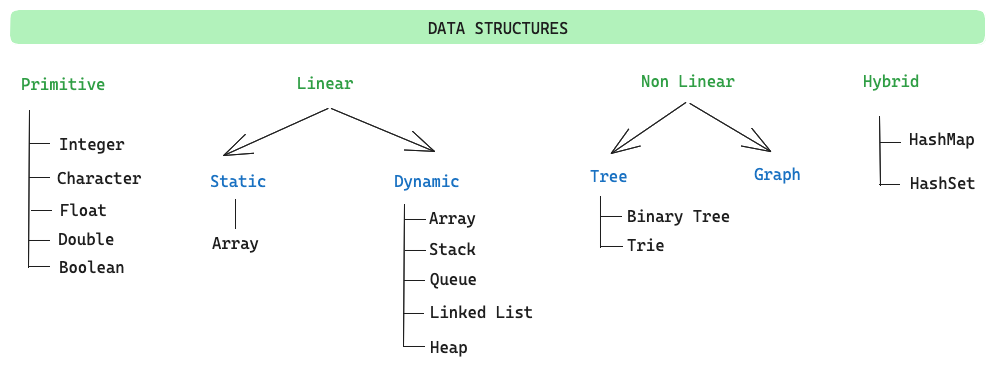Imagine you’re a librarian. You’ve got thousands of books arriving, and you need a way to organize them. A good organization method would let people find, borrow, and return books quickly and efficiently. Computers have a similar challenge. They need ways to store, organize, and retrieve data. And just as our librarian make use of shelves, cabinets, and sections, computers use data structures.
A data structure is a particular way of organizing data in a computer memory so that it can be used efficiently.
More formally, A data structure is a systematic way of organizing, storing, and managing data so that it can be accessed and modified efficiently.
Category of Data Structures
Data structures can be categorized as primitive or non-primitive.
Primitive Data Structures
These are the basic data structures that directly represent a single value. They are the building blocks for more complex structures. They have predefined behaviors and operations in most programming languages.
- Integer: Represents whole numbers. E.g., -3, 0, 42.
- Float (or Double): Represents numbers with decimal points. E.g., -3.14, 0.001, 42.0.
- Character: Represents single symbols or letters. E.g., ‘a’, ‘A’, ‘1’, ‘!’.
- Boolean: Represents true or false values.
Non-Primitive Data Structures:
These are more complex structures derived from primitive ones, designed to handle multiple values and provide a means to structure and organize large amounts of data.
- Linear Data Structures:
- Array: A collection of items of the same type stored at contiguous memory locations. It is characterized by index-based access.
- Linked List: A collection of items where each item points to the next one in the sequence. It provides dynamic memory allocation.
- Stack: A last-in-first-out (LIFO) collection of items, with operations to push (add) and pop (remove) from the end.
- Queue: A first-in-first-out (FIFO) collection of items, with operations to enqueue (add) at the end and dequeue (remove) from the front.
- Non-Linear Data Structures:
- Tree: A hierarchical structure with a root element and a collection of subtrees. Common types include binary trees, AVL trees, and B-trees.
- Graph: A collection of nodes connected by edges. Graphs can be directed or undirected, weighted or unweighted.
Why We Need Data Structures?
Data structures are essential for the following reasons:
- Efficiency: They enable efficient data manipulation, optimizing both time (speed of operations) and space (memory usage).
- Abstraction: They offer a way to represent and manage complex data, simplifying problem-solving.
- Flexibility: Different problems require different ways of data handling. Data structures provide diverse solutions tailored to specific needs.
- Reusability: Once defined, they can be used across multiple applications, reducing redundant effort.
- Foundation for Algorithms: They serve as the basis for algorithm design. The effectiveness of an algorithm often hinges on the choice of data structure.
In essence, data structures empower us to solve complex problems in an optimized and organized manner.
Conclusion
Data structures are like the scaffolding on which we build our programs. They offer ways to manage and process data efficiently. The choice of a data structure often depends on the nature of the application, the specific operations to be performed, and the trade-offs between time and space complexity.
